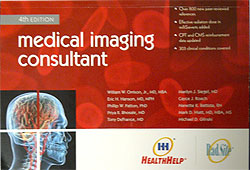This niche handbook is based on a straightforward concept. For a given disease, it describes the imaging test of choice. As a bonus, the book also provides information about relative costs, harms, benefits and chest x-ray equivalents and so forth.
So if you would like to know, for example, what the test of choice is for suspected atlantoaxial subluxation, you can look it up (p. 144). According to the authors, a single lateral cervical spine radiograph “in comfortable flexion will reveal most significant subluxations.” The confirmatory test for cord compromise is “flexion-extension sagittal MRI” without contrast.

Many of the choices are relatively straightforward. For example, sensorineural hearing loss? Brain MRI – and don’t forget the contrast. However, some choices are a bit more complicated. For example, what’s the best imaging study for thyroid cancer? It depends!
- for screening: ultrasound of the head and neck
- for assessing the relationship of the carotid vasculature to the tumor tissue: MRI of the orbit, face, and neck with and without contrast
- for assessing the chest and mediastinum: CT with and without contrast
- for demonstrating metastatic disease from papillary carcinoma: whole body iodine-131 (I-131) radionuclide scanning
The psychiatry section gets a bit dicey, as one might imagine, and I would like to see a more user-friendly index in future editions. Despite these relatively minor drawbacks, the handbook is extremely valuable in helping practitioners select the appropriate imagine study for almost any clinical scenario.
I therefore highly recommend Medical Imaging Consultant, 4th Edition, by William W. Orrison JR, MD, MBA et al.


Leave a Reply